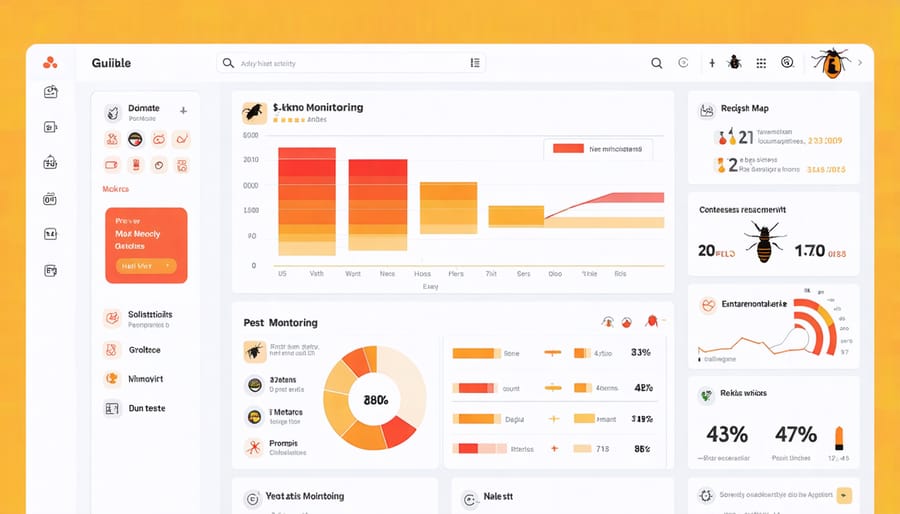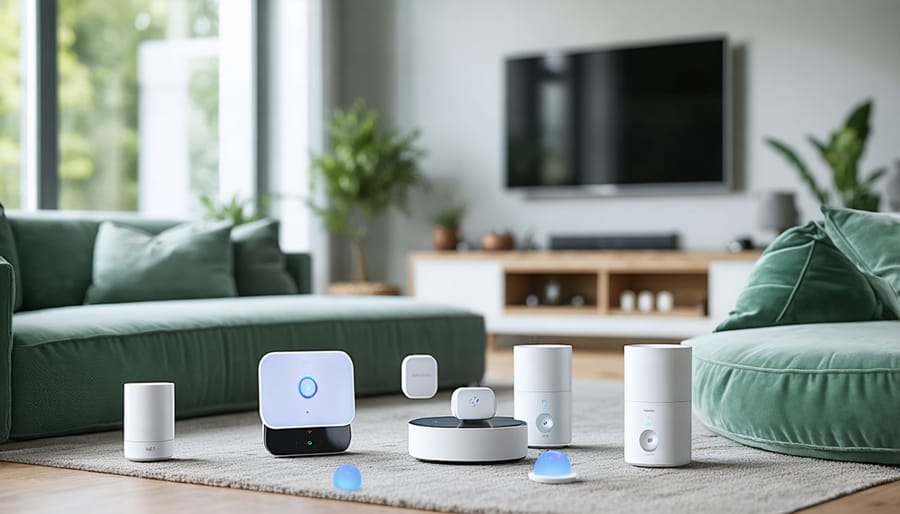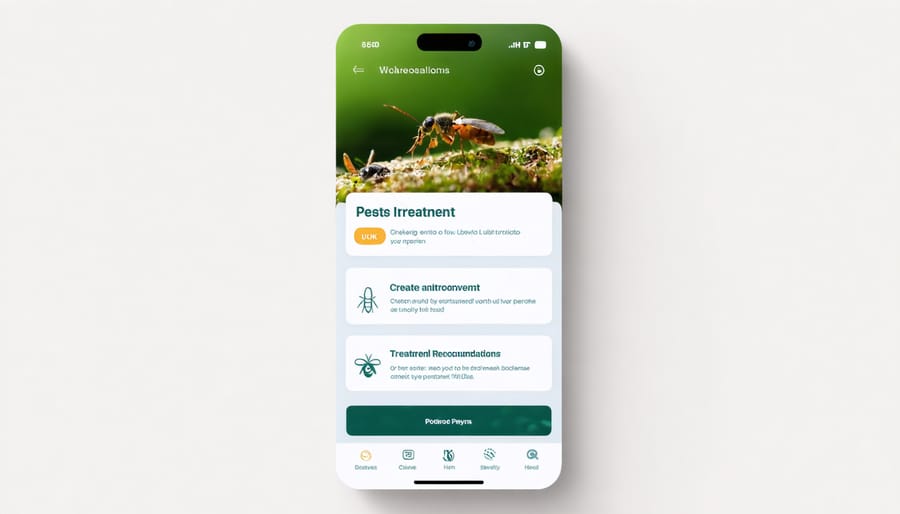Transform your pest management approach with modern software that monitors, predicts, and automates pest control across your property. Like other smart home automation solutions, integrated pest management (IPM) software combines sensors, data analytics, and mobile apps to create a comprehensive defense system against unwanted visitors.
Track pest activity patterns through wireless sensors that alert your smartphone when unusual movement is detected. Set up automated responses like timed treatments, humidity control, and temperature adjustments that naturally deter common household pests. Monitor treatment effectiveness and adjust strategies in real-time through user-friendly dashboards that provide clear insights without requiring technical expertise.
This modern approach eliminates the guesswork from traditional pest control methods while reducing chemical usage by up to 70%. Whether you’re dealing with seasonal invaders or year-round concerns, IPM software provides the intelligent oversight needed to protect your home while maintaining a healthy, sustainable environment for your family.
What Makes IPM Software Different from Traditional Pest Control
Real-time Monitoring and Detection
Modern pest management has become smarter and more efficient with automated monitoring systems that keep a watchful eye on your home 24/7. These intelligent sensors work like tiny guards, detecting pest activity through various methods such as motion, heat signatures, and even specific sound frequencies that different pests make.
Imagine having a network of small, discreet sensors placed strategically around your home that can alert you the moment unwanted visitors arrive. These smart devices can distinguish between harmless house pets and problematic pests, sending real-time notifications to your smartphone when there’s suspicious activity.
The beauty of these systems lies in their ability to learn and adapt. Over time, they create patterns of pest behavior specific to your property, helping you predict and prevent infestations before they become serious problems. Many systems also include moisture and temperature monitoring, which helps identify conditions that might attract pests in the first place.
Best of all, these monitoring solutions integrate seamlessly with your existing smart home setup, giving you complete control and peace of mind right from your phone or tablet.
Data-Driven Decision Making
Modern pest management software acts like a smart detective, collecting and analyzing data about pest activities in and around your home. By tracking factors like seasonal patterns, weather conditions, and pest sightings, these intelligent systems create a detailed picture of your pest situation. The software processes this information to identify trends, such as which seasons certain pests are most active or which areas of your home are most vulnerable.
What makes this technology particularly helpful is its ability to suggest targeted solutions based on your specific situation. Instead of using a one-size-fits-all approach, the software recommends customized treatment plans that consider your home’s unique characteristics, local climate, and pest history. For example, if the system notices an uptick in ant activity during spring months near your kitchen, it might suggest specific prevention measures before the season begins.
The software also helps you make smarter decisions about when and where to apply treatments. By analyzing historical data and current conditions, it can predict pest problems before they become serious, helping you take preventive action at just the right time. This data-driven approach not only makes pest control more effective but also helps reduce unnecessary chemical use in your home.

Setting Up Your Smart IPM System
Essential Hardware Components
To get the most out of your integrated pest management system, you’ll need a few key hardware components working together. At the heart of your setup are motion sensors and infrared detectors, which work like vigilant guards monitoring your space 24/7. These sensors can be as simple as basic motion detectors or as sophisticated as smart Zigbee devices that integrate seamlessly with your existing smart home system.
High-resolution cameras are another essential component, helping you identify and track pest activity. Look for models with night vision capabilities and weather resistance for outdoor installations. Many homeowners find that combining wide-angle cameras for general surveillance with focused cameras in problem areas works best.
The control unit serves as the brain of your system, processing data from your sensors and cameras while managing your response devices. Modern units typically include a user-friendly interface, often accessible through your smartphone or tablet.
Don’t forget about response devices – these might include ultrasonic repellers, automated sprayers, or smart traps that notify you when they’re activated. While these components might seem like a significant investment upfront, they form a comprehensive system that provides long-term, effective pest management while reducing the need for harsh chemicals in your home.

Software Integration Tips
Setting up your integrated pest management software doesn’t have to be complicated. Start by downloading the main app to your smartphone – this will serve as your central control hub. Most systems come with a straightforward setup wizard that walks you through the process step by step.
When connecting your monitoring devices, place them near common pest entry points like windows, doors, and utility openings. Make sure each sensor is within range of your home’s Wi-Fi network. As you add each device, give it a descriptive name (like “Kitchen Window” or “Garage Door”) to make identification easier later.
Your management dashboard is where the magic happens. Take time to customize your notification preferences – you probably want immediate alerts for active pest detection but maybe weekly summaries for general monitoring. Most software allows you to set different sensitivity levels for different areas of your home.
To get the most from your system, connect it with your other smart home devices. Many platforms work with virtual assistants like Alexa or Google Home, letting you check pest activity with voice commands. Some even integrate with smart lighting and sprinkler systems for automated pest deterrence.
Remember to test your setup by triggering each sensor manually. This helps ensure everything’s working properly and familiarizes you with how the system responds to different types of activity.
Daily Use and Maintenance
Monitoring Dashboard Features
The monitoring dashboard is your command center for keeping pests at bay, offering a user-friendly interface that puts control right at your fingertips. Like other smart control systems, these dashboards provide real-time alerts when pest activity is detected, helping you respond quickly to potential infestations.
You’ll receive customizable reports showing pest activity patterns, helping you identify trouble spots and peak activity times. The dashboard typically displays easy-to-read charts and graphs, making it simple to track the effectiveness of your pest control efforts over time. Color-coded alerts prioritize your attention where it’s needed most – green for routine monitoring, yellow for increased activity, and red for immediate attention required.
Control options are readily accessible through the dashboard, allowing you to activate deterrent measures, adjust sensitivity settings, or schedule preventive treatments. Many systems also offer mobile app integration, so you can monitor and respond to alerts even when you’re away from home.
The dashboard maintains a detailed history of pest activities and your responses, which helps in fine-tuning your prevention strategy and documenting the success of your pest management efforts. This historical data is invaluable for identifying seasonal patterns and preparing for future pest challenges.

Regular System Updates
Just like your smartphone needs regular updates, your pest management software requires consistent maintenance to work effectively. Think of these updates as giving your system a fresh boost of intelligence to tackle those unwanted visitors. Regular updates bring you the latest features, security patches, and improved detection algorithms that help your system stay one step ahead of pest problems.
Set up automatic updates whenever possible – this ensures you never miss critical improvements. Most modern systems can schedule these updates during off-peak hours, typically late at night, so they won’t disrupt your daily routine. While the software updates itself, take a moment every month to check that your sensors are clean and properly positioned.
Don’t forget about your system’s mobile app! Keep it updated on all your connected devices to maintain seamless communication with your home hub. These updates often include valuable new features like improved reporting tools or enhanced notification settings that make managing pest control even easier.
Remember to back up your pest activity data before major updates. This information is golden for tracking seasonal patterns and understanding which prevention strategies work best for your home. If you’re ever unsure about an update, most manufacturers offer helpful online guides or customer support to walk you through the process.
Smart IPM Success Stories
Meet Sarah from Denver, who transformed her ongoing ant problem using a smart IPM system. After installing motion sensors and a smartphone-connected monitoring system, she was able to identify that ants were entering through a tiny crack near her kitchen window – something she might have missed with traditional methods. The app helped her track ant activity patterns and suggested sealing the entry point rather than immediately reaching for pesticides.
In Seattle, the Johnson family struggled with seasonal moth infestations until they implemented an IPM software solution. Their system’s humidity sensors revealed unusually high moisture levels in their closets, creating perfect conditions for moths. Following the app’s recommendations, they installed a dehumidifier and organized their clothing storage, reducing moth problems by 90% without using any chemicals.
Another success story comes from the Garcia household in Austin, where their smart IPM system’s thermal imaging feature detected unusual heat patterns in their walls – a sign of rodent activity. The software guided them through a systematic approach: first sealing entry points, then using ultrasonic deterrents, and finally implementing preventive measures around their home’s exterior.
Perhaps most impressive is retired teacher Linda’s experience in Florida. Her IPM app’s weather integration feature helped her prevent seasonal pest issues by alerting her to conditions favorable for pest activity. She now proactively manages potential problems before they start, saving hundreds on pest control services annually while maintaining a pest-free home using primarily non-chemical methods.
Embracing integrated pest management software is a smart step toward creating a safer, more efficient home environment. By combining smart technology with proven pest control methods, you’re not just solving current pest problems – you’re preventing future ones while saving time and money. The automatic monitoring, real-time alerts, and data-driven approach mean you can catch issues early and respond effectively, without overusing harmful chemicals or waiting until problems become severe.
Remember, successful pest management isn’t about eliminating all insects and wildlife – it’s about maintaining a healthy balance while protecting your home. With IPM software, you have a powerful ally that helps you make informed decisions, track progress, and adjust your strategy as needed. Whether you’re dealing with seasonal pests or year-round concerns, these digital tools make it easier to stay on top of the situation.
Start small by implementing basic monitoring features, then gradually expand your system as you become more comfortable with the technology. Your investment in IPM software today will pay dividends in a cleaner, healthier home tomorrow.
